|
|
|
|

Karura 迦楼羅, Karura-Ō 迦楼羅王 (Skt. = Garuda)
Bird of Life, Celestial Eagle, Half Bird Half Man
ORIGIN = HINDU MYTHOLOGY
Member of the TENBU. One of EIGHT LEGIONS Guarding Buddhism.
One of 28 LEGIONS Guarding the 1000-ARMED KANNON BODHISATTVA.
One of KANNON’S 33 BASIC MANIFESTATIONS.
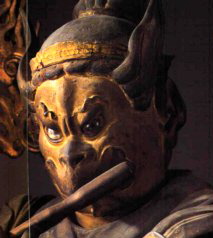 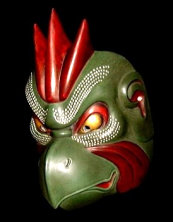 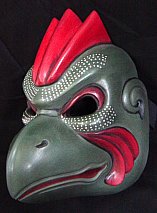
(L) Karura at Sanjūsangendō 三十三間堂 in Kyoto (see full image below)
(M) Modern NOH Mask. Found on J-web. (R) Modern NOH Mask. Found on J-web.
See Learn More section below for links to these J-web estores.
|

Karura, Sanjūsangendō 三十三間堂 (Kyoto)
Kamakura Era, Wood, Photo this J-book
|
|
 Karura 迦楼羅 Karura 迦楼羅
Sanskrit = Garuḍa (the Devourer), Chinese = Jiālóuluó
Japanese = Karura, Korean = 가루라, Tibet = Khyung
A mythical bird-man creature of Hindu lore who was later adopted into the Buddhist pantheon as a protector deity. The gold-colored Garuda (Skt.) has a human body but the wings, face, and beak of an eagle-like bird. In early Hindu literature, Garuda is granted immortality by Lord Vishnu and serves as Vishnu’s mount (avatar). In Tibetan tradition, Garuda is a mythical bird, similar to an eagle, but of gigantic proportions, able to block the sunlight with its size. In Japan, Garuda is an enormous fire-breathing eagle-man with golden feathers and magic gems crowning its head. Garuda’s various attributes are:
- Personifies the blazing rays of sun, the wind, and the esoteric teachings of the Vedas (Indian texts of sacred knowledge).
- Fierce bird of prey, variously described as an eagle, hawk, or kite. Can spew fire from mouth; flapping of wings sounds like clap of thunder.
- Mortal Enemy of the naga, a Hindu group including serpents & dragons. Karura feeds on the naga.
- Only naga who possess a Buddhist talisman, or naga who have converted to Buddhism, can escape from the naga-eating Karura. <Source: Flammarion>
- Karura’s hatred of the naga stems from an ancient feud between Karura’s mother (Skt. Vinata) and her sister (the mother of the naga).
- First to teach mankind how to cure snake poison.
- In Vedic and Hindu mythology, Karura steals the nectar of immortality from Indra in order to gain the release of his enslaved mother. The pot of nectar is eventually returned to Indra, on condition that Indra grant Karura permission to feed on naga.
- In the Purana (religious texts of ancient Hindu myths), Karura accidentally drops the bile of a slain Ashura; the bile falls to earth where it solidifies into veins of emerald. This story sparked the belief that touching emeralds neutralizes any poison.
- In Southeast Asia the walls of temples are often decorated with Karura, as at Angkor and Java
- Carries the sacred Nyoi Hōju 如意宝珠 (Chn. = Rúyì 如意) jewel on its neck. This pearl is said to grant every wish and remove every suffering. According to legend, this jewel emerged from the head of the dragon king 竜王. <Sources: JAANUS and Digital Dictionary of Chinese Buddhism>
- Garuda is sometimes translated into English as griffin. <Source: Digital Dictionary of Chinese Buddhism; sign in with user name “guest”>
- In Japanese art, Karura is depicted as an ornate bird with human head; sometimes shown treading on serpents or holding serpents. Karura does not appear often in Japanese Buddhist sculpture, and is rarely the object of central devotion.
- In Japanese art, Karura is one of the 33 Manifestations of Kannon Bodhisattva. See photo below.
- Like the Phoenix, Garuḍa is associated with fire and serves as a symbol of flame (said to represent the purification of the mind by the burning away of all material desires). In Japan, the term Karura-en 迦楼羅焔 refers to the flames spewed from Karura’s mouth, while the term Karura Enkō 迦楼羅焔光 refers to the feiry halo (kaen kōhai 火焔光背) often attached to statues of Fudō Myō-ō. Some say Fudō’s customary flame halo originated from the vomit of Karura, while others say the halo resembles Karura’s outstretched wings. Karura’s head is sometimes depicted on Fudō’s halo as well. <Source: JAANUS>
- There is a great deal of confusion about Karura and the mythical Phoenix. Many web sites refer to the Karura as Phoenix, and vice versa, but this is wrong. The two are different mythical creatures.
- Garuda is the national symbol of both Thailand and Indonesia. The national airline of Indonesian, moreover, is named Garuda Indonesia.

|

Karura. Painted Wood. One of Kannon’s 33 Forms
Hase Dera (Hase Kannon Temple) in Kamakura
From a set of 33 presented to Hase Dera
by Shogun Yoshimasa (1449-1471 AD)
|
The 25th chapter of the Lotus Sutra (Hokke-kyō 法華経) is popularly known as the Kannon Sutra (Jp. Kannonkyō 觀音経). It lists thirty-three forms that Kannon assumes when aiding sentient beings, including that of a Karura, dragon, monk, nun, official, child, general, king, & Buddha.
|
|
|
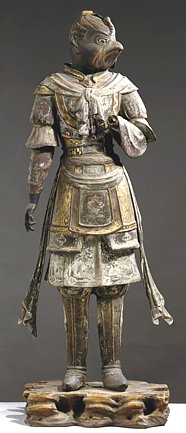
Karura, Kōfukuji Temple, Nara
Hollow dry lacquer (dakkatsu kanshitsu 脱活乾漆)
H = 149 cm, Nara Period, National Treasure
|
|
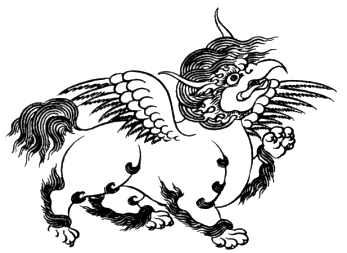
Head of Garuda with body of Lion
The Eight-Legged Lion - Son of Union between Garuda and Lion.
One of the Three Symbols of Victory in the Fight against Disharmony.
From Buddhist Symbols in Tibetan Culture, by Loden Sherap Dagyab Rinpoche
Wisdom Publications, ISBN 0-86171-047-9. Click here to buy book at Amazon

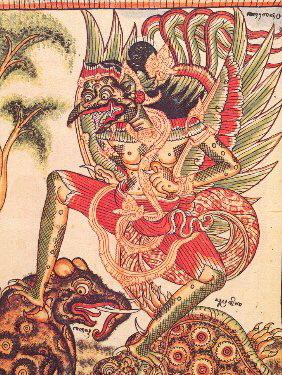
Image made by Ida Made Tlaga in Sanur (Bali) around 1880.
The original is kept at the library of Leiden University. Photo courtesy of Wikipedia

|
BELOW FROM THIS J-SITE
|
|
Karura is the name of a legendary bird
Karura flys in the four heavens over Mt. Shumisen
Eating dragons
Its wings shine with a golden color
Magical gems are at its head
Blazes from its mouth
Over 1,200 km. in size
|
迦楼羅(かるら)は伝説上の鳥の名前。
須弥山(しゅみせん)の四天を翔り(かけり)
龍を獲って食とする
翼は金色(こんじき)
頭に如意珠(にょいじゅ)
常に口から火炎を吐く
その大きさ三百余里
|
|
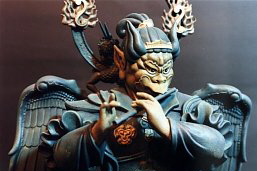
Photo courtesy of www.mediawars.ne.jp

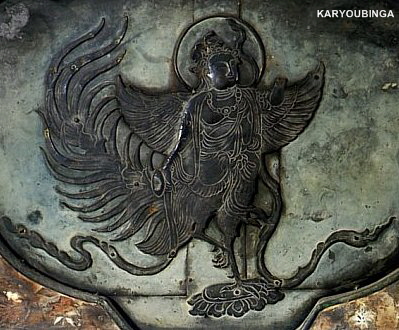
Karura is sometimes associated / confused with Karyōbinga.
Karyōbinga Engraving on Octogonal Pedestal, Chūsonji Temple 中尊寺, 12th Century
(Length) 193.9 cm (Height) 52.5cm., Photo courtesy 日本の美をめぐる, No. 35
Karyōbinga (Skt. = Kalavinka) 迦陵頻伽
Celestial beings who play music, dance, and fly through the air. They appear in many forms,
often with bird’s body and angelic head, and are sometimes associated with Amida Nyorai.
They appear often in Buddhist paintings, ritual robes, murals, and temple decorations.

LEARN MORE
 Handbook on Viewing Buddhist Statues 仏像の見方, ハンドブック. Japanese language only; 192 pages; 80 or so color photos. Author Ishii Ayako 石井 亜矢子. Handbook on Viewing Buddhist Statues 仏像の見方, ハンドブック. Japanese language only; 192 pages; 80 or so color photos. Author Ishii Ayako 石井 亜矢子.
- JAANUS. Japanese Architecture & Art Net Users System. Compiled by the late Dr. Mary Neighbour Parent; covers both Buddhist and Shinto deities in great detail and contains over 8,000 entries.
- A Dictionary of Chinese Buddhist Terms. With Sanskrit & English Equivalents. Plus Sanskrit-Pali Index. By William Edward Soothill & Lewis Hodous. Hardcover, 530 pages. Published by Munshirm Manoharlal. Reprinted March 31, 2005. ISBN 8121511453.
- Digital Dictionary of Chinese Buddhism (C. Muller; login "guest")
- Buddhism: Flammarion Iconographic Guides, by Louis Frederic, Printed in France, ISBN 2-08013-558-9, First published 1995.
- Dictionary of Hindu Lore and Legend. By Anna L. Dallapiccola, Publisher Thames & Hudson, 2002. According to the dicitionary: “Garuda’s other names include: Amritaharana (stealer of the nectar), Gaganeshvara (lord of the sky), Nagantaka (destroyer of serpents), Shalmalin (taloned), Suparna (having beautiful wings), and Vainateya (sone of Vinata).” See page 83.
- Numerous temple brochures and exhibition catalogs (Japanese and English). See list of resources on our Bibliography page.
- Karura NOH Masks - Online Stores
|
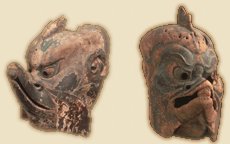
Japanese GIGAKU Masks of Karura
At the Tokyo National Museum
Gigaku 伎楽 = Masked theatrical performances.
In Japan, Karura 迦楼羅 also refers to a gigakumen 伎楽面 (gigaku mask) representing the mythical bird and used in a gigaku bird dance that was performed during the 8th to 12th century.
|
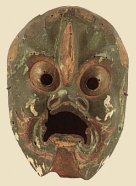
Karura, Gyōdōmen 行道面 Mask, Heian Era
12th Century, Hōryūji Temple 法隆寺, Nara
Gyōdōmen = Parade masks to teach the
commoner about gaining good karma
|
|

|
|